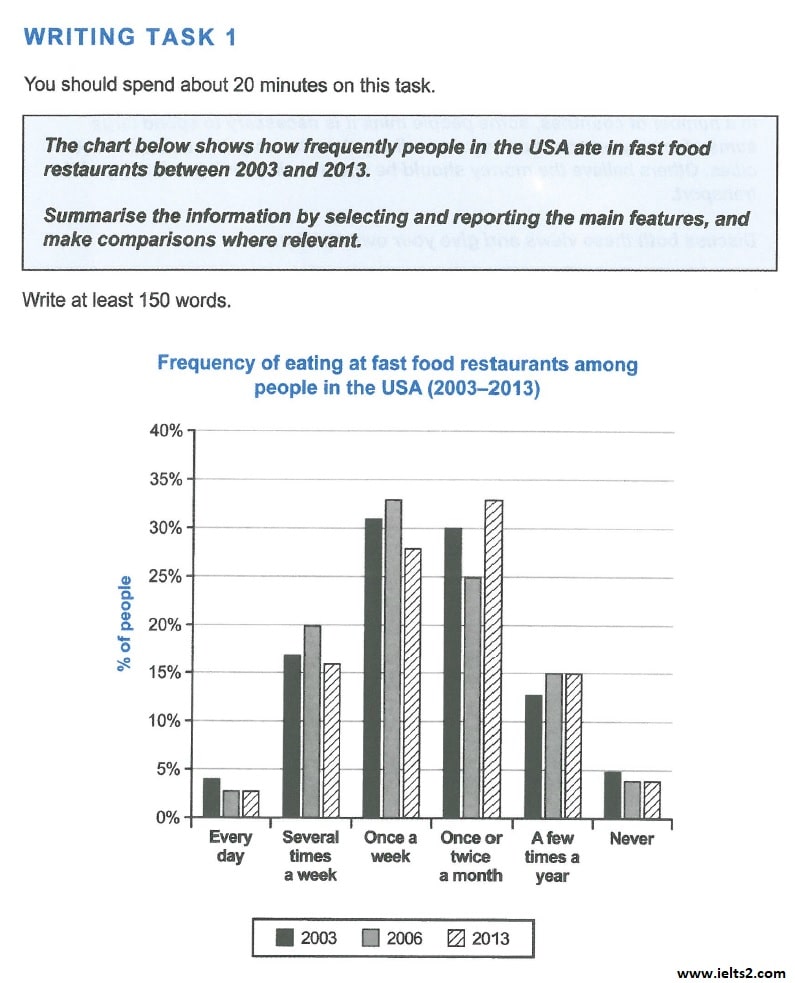رایتینگ نمودار میله ای کمبریج آیلتس جلد 12 آکادمیک تست 3
Cambridge IELTS Academic 12 Test 3 Task 1 Bar Chart Band 9
در اینجا یک نمودار میله ای از تست 3 جلد 12 سری کتاب های کمبریج آیلتس آکادمیک را همراه با جواب نمره 8 تا 9 با هم میبینیم. این رایتینگ از انواع Bar Chart می باشد و پاسخگویی به آن نیازمند شناسایی و دسته بندی اطلاعات اصلی یا Main Feature ها در نمودار و گزارش آن ها در 4 پاراگراف (مقدمه و جمع بندی و 2 پاراگراف توضیحات اصلی) است. بعد از ارایه نمونه نمره 8 برای این نمودار، تحلیل و آنالیز گرامر و لغات آکادمیک همین سمپل را خواهیم داشت. اگر با این بخش از رایتینگ نویسی آیلتس آکادمیک آشنایی ندارید، انواع 7 نوع سوال در تسک 1 رایتینگ آیلتس آکادمیک پیشنهاد بعدی ما به شما عزیزان است.
سوال رایتینگ نمودار میله ای کمبریج آیلتس آکادمیک 12 تست 3 تسک 1

متن سوال کمبریج 12 تست 3 آکادمیک رایتینگ تسک 1 (نمودار میله ای)
The chart below shows how frequently people in the USA ate in fast food restaurants between 2003 and 2013.
Summarise the information by selecting and reporting the main features, and make comparisons where relevant.
نمونه پاسخ نمره 9:
The bar chart illustrates the frequency with which individuals in the USA dined at fast-food outlets between 2003 and 2013.
Overall, in all three years, a considerably higher percentage of the population ate at fast-food restaurants either once a week or once or twice a month. In contrast, only a small proportion of people reported dining at fast-food outlets daily or never eating there.
A notable 31% to 33% of people in the USA ate at fast-food restaurants once a week in both 2003 and 2006, although this proportion experienced a slight decline to approximately 27% in 2013. Those who ate at fast-food outlets once or twice a month also accounted for a significant share of the population in all three years. This proportion initially fell from 30% in 2003 to 25% in 2006, before rising to around 33% by 2013.
The percentage of people eating at fast-food restaurants several times a week ranged between 15% and 20%, while those dining there a few times a year saw an increase from around 13% to 15% during the period. On the other hand, in all three years, less than 5% of people fell into the “every day” or “never” categories.
لغات و ساختارهای گرامری پیشرفته به کار رفته کمبریج 12 تست 3 آکادمیک رایتینگ تسک 1
در اینجا گرامر و ساختارهای لغوی سطح پیشرفته در این سمپل را با هم میبیینم.
Comparative Structures:
- Example: “A significantly higher proportion of the US population ate in fast-food restaurants either once a week or once or twice a month.”
- Explanation: This structure is used to compare different groups and highlight the major trends. Using “significantly higher” emphasizes the large difference in frequency between the most common categories.
- Passive Voice:
- Example: “The proportion of those eating in fast-food restaurants several times a week varied…”
- Explanation: Passive voice here is used to focus on the data rather than the actors. It adds formality and objectivity to the response, which is important for academic writing.
- Time Expressions:
- Example: “Between 2003 and 2013”
- Explanation: Time expressions are important for indicating the time frame covered by the chart, ensuring clarity in the description of trends.
- Quantitative Data Reporting:
- Example: “31% to 33%,” “around 27%,” “approximately 33%”
- Explanation: Accurately reporting numerical data is essential in Task 1. Specific percentages give a precise account of the data, making the response more objective and factual.
- Use of Modifiers:
- Example: “A moderate decline,” “a significant proportion”
- Explanation: Modifiers such as “moderate” and “significant” provide more depth to the analysis. They show the degree of change and help describe trends without being overly vague.
فرمت رایتینگ تسک 1 برای نمره کامل:
- Introduction:
- Purpose: Paraphrase the question and give an overview of what the chart represents.
- Example: “The bar chart illustrates the frequency with which individuals in the USA dined at fast-food outlets between 2003 and 2013.”
- Overview:
- Purpose: Summarize the key trends observed in the chart. This should be an objective and concise summary of the most important patterns.
- Example: “Overall, in all three years, a considerably higher percentage of the population ate at fast-food restaurants either once a week or once or twice a month.”
- Body Paragraphs:
- Purpose: Provide a detailed description of the data. The first body paragraph could describe the most frequent categories, and the second could focus on the less frequent ones.
- Example: “A notable 31% to 33% of people in the USA ate at fast-food restaurants once a week in both 2003 and 2006, although this proportion experienced a slight decline to approximately 27% in 2013.”
- Use of Data and Details:
- Purpose: Include specific figures and trends. This adds accuracy and helps the reader understand the extent of the changes.
- Example: “The percentage of people eating at fast-food restaurants several times a week ranged between 15% and 20%.”
- Cohesion and Coherence:
- Purpose: Ensure the ideas flow logically with appropriate transitions between sentences and paragraphs. Cohesive devices like “In contrast,” “On the other hand,” and “Initially” help to guide the reader through the description of trends.
- Example: “On the other hand, in all three years, less than 5% of people fell into the ‘every day’ or ‘never’ categories.”
- Formal and Objective Tone:
- Purpose: Use a neutral tone, avoiding personal opinions. Academic writing should focus on the data and its interpretation, rather than subjective views.
- Example: “A small proportion of people reported dining at fast-food outlets daily or never eating there.”
نمونه های بیشتر و تصحیح رایگان رایتینگ شما ❤️
100 نمونه رایتینگ آیلتس پیشنهاد آخر ما به دوستان گرامی هست. این نمونه رایتینگ های تسک 1 آیلتس از پرتکرار ترین نوع سوالات این بخش و همچنین جدیدترین موضوعات می باشند. این مجموعه توسط یکی از سایت های معتبر انگلیسی زبان فعال در حوزه آیلتس تنظیم شده است. همچنین برای تصحیح رایگان رایتینگ آیلتس تسک 1 و 2 به صورت نامحدود در کانال تلگرام رایتینگ ما همراه باشید و به ادمین برای تصحیح رایتینگ اطلاع دهید.






